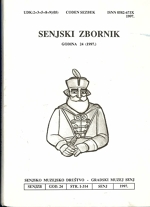ETNIČKA I KONFESIONALNA PODJELA NAKON OSLOBAĐANJA LIKE OD TURAKA
ETHNICAL AND RELIGIOUS DIVISION AFTER LIBERATION OF LIKA FROM TURKS
Author(s): Damjan PešutSubject(s): Military history, Political history, Social history, 17th Century, Migration Studies, Ethnic Minorities Studies
Published by: Senjsko muzejsko društvo i Gradski muzej Senj
Keywords: ethnical and religious division; liberation; Lika; Turks;
Summary/Abstract: During 160 years of Turkish domination, one part of people from Lika moved to the region of Senj and Kranjska, the other one to the northern Dalmatia and Podgorje, while the third never left their ancient homes. The exile of the population of Lika and Krbava was going on almost permanently with special intensity after 1527. i.e. during the period of the occupation of Krbava and Lika, then in the middle of the 16th c. and after the break of the resistance in Lika from the beginning to the mid 17th c. The part of Lika's people, who moved to the region of Senj, preserved their ancient tradition, which was afterwards continued by their descendants even after their comeback to the ancestral estates. The whole population of Lika, with Serbs and more numerous Croats, belonged to the Old-Catholic Croatian churc congregation. During the first half of 18th c. that congregation was subdued by the Roman Catholic and Greek Oriental chuech, so that Roman Propaganda had a strong influence on the Croats, while the Greek Oriental church diocese of Karlovac had an impact on the Serbs. Disappearing of the Croatian Catholic church was acceleratted after the death Marko Mesić, the Archdeacon of Lika, and was completed after the death of Marko's successor Damjan Zduna.
Journal: Senjski zbornik - prilozi za geografiju, etnologiju, gospodarstvo, povijest i kulturu
- Issue Year: 24/1997
- Issue No: 1
- Page Range: 85-130
- Page Count: 46
- Language: Croatian

